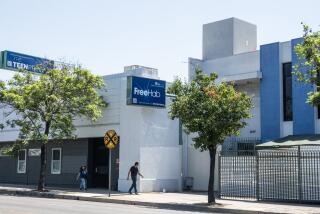An Oasis for Recovering Addicts : Treatment: San Pedro program helps reclaim neighborhood as well as lives. It turned decaying buildings into affordable quarters for sober living.
In a seedy section of San Pedro, men who once slept in gutters and dined at dumpsters now sleep in beds beneath colorful quilts and give thanks at a common table for another day of sobriety.
Men whose alcohol and drug addictions cost them their jobs, families, friends and future are getting another chance. And they say they have the Beacon House to thank.
According to its supporters among county and state drug treatment officials, Beacon House is a good example of how âsober living housesâ save lives and sometimes help reclaim neighborhoods from the ravages of drugs.
In 1985, the nonprofit Beacon House recovery center began transforming neighboring houses and apartment buildings--all of them deteriorating, some already condemned--into clean, safe and affordable places for recovering addicts to live.
âThere was just nowhere for our people to go,â said Beacon House Director Mary Proper. âWe couldnât keep bringing people into our living rooms to sleep on sofas.â
Eventually, Beacon House took over eight apartment buildings and houses, and brought them up to health, safety and building code standards.
âIn one building, we had to install a $5,000 fire alarm system,â Proper said. âEverywhere, we had tremendous renovations. We put in new kitchens and baths, applied new paint and laid carpet and floors.â
The result: a drug-free oasis in a crime-infested neighborhood. And, for recovering addicts, a good place to live and start over.
For one resident, that meant entering law school. Another completed a Ph.D. in history. Two physicians who came to Beacon House have been able to resume their practices. Some husbands and fathers have been reunited with their families.
Kendric Knox, a onetime college football player, says he âgot lost in 10 years of drinking and drugging.â But now he lives in one of Beacon Houseâs spacious bachelor apartments and is volunteering as a coach at a local community college. âEverything you need for a new life is right here,â he said.
Knox, like the other 100 or so men in the Beacon House network, pays about $300 per month for a room and another $80 to eat with others in a large dining room. Those who have no resources pay nothing, and residents who are on relief are charged according to their ability to pay.
In addition to rental income, Beacon House raises money from bake sales, carwashes and donations. Some of the homes were furnished or remodeled with county start-up funds.
The houses are run by elected âresident presidents,â who rotate the job every six months and are responsible for running house meetings, arranging for repairs and helping residents clothe themselves for job interviews.
If residents violate rules against drinking or using drugs, they are expelled from the houses.
Despite occasional relapses, most of the residents eventually return to work or to school to retool for new careers, Proper said.
Everyone associated with Beacon House is encouraged to take on civic duties. For Knox, that means overseeing an after-school youth program he helped start at a nearby church. Former military police officer K. C. Collins serves on the San Pedro Chamber of Commerce and a community anti-crime committee. Book lover Jim Esterline tutors adults in reading and writing at the local library.
âItâs not enough to live here; we feel weâve got a mission here,â Collins said. âWe need to feel needed. And around here, we are. I guess you could say we couldnât have found a better home.â
More to Read
Sign up for Essential California
The most important California stories and recommendations in your inbox every morning.
You may occasionally receive promotional content from the Los Angeles Times.










